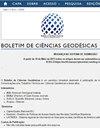利用每颗GPS和glonass卫星的实时σ维格对巴西巴西国际机场精确进近防护等级进行估算和分析
IF 0.5
Q3 Earth and Planetary Sciences
引用次数: 3
摘要
利用巴西里约热内卢国际机场(SBGL)地基增强系统(GBAS)中每颗全球定位系统(GPS)和全球导航系统(GLONASS)卫星的实时电离层垂直梯度标准差(σ vig)测定,估算了机场的水平和垂直防护等级(HPL/VPL)。为此,开发了MoR_Ion_RT(巴西GBAS电离层威胁实时评估)和SBGL_PL (SBGL HPL/VPL计算)两个软件,给出了软件的实现方法和计算公式。由于这样的确定传送了飞机接近时电离层的真实情况,因此它们还允许根据美国相邻威胁模型阈值对数据进行筛选。进行的实验表明,在SBGL的秋季(受影响最严重的季节)使用GPS或GLONASS卫星参加CAT-I是可能的,前提是应用为该地区开发的时间电离层威胁模型建立的限制(避免使用海拔在10°至37°之间的卫星)。还发现,将GLONASS与全球定位系统卫星结合使用可以达到第iii类水平和垂直警报极限(HAL/VAL),因为它具有更好的几何结构。本文章由计算机程序翻译,如有差异,请以英文原文为准。
ESTIMATION AND ANALYSIS OF PROTECTION LEVELS FOR PRECISE APPROACH AT RIO DE JANEIRO INTERNATIONAL AIRPORT USING REAL TIME σVIG FOR EACH GPS AND GLONASS SATELLITE
: Determinations of the vertical ionospheric gradient standard deviation (σ vig ) in real time to each Global Positioning System (GPS) and Globalnaya Navigatsionnaya Sputnikovaya Sistema (GLONASS) satellite available in Ground-Based Augmentation System (GBAS) of the Rio de Janeiro International Airport (SBGL) were used in the estimates of Horizontal and Vertical Protection Level (HPL/VPL). For this purpose two software were developed: MoR_Ion_RT (real time ionospheric threat assessment for GBAS in Brazil) and SBGL_PL (calculation of SBGL HPL/VPL), whose methods and equations are presented in this paper. Since such determinations transmit the real ionospheric condition at the time of an approaching aircraft, they also allow performing the screening of the data, based on the Conterminous United States (CONUS) Threat Model threshold. Experiments carried out indicate that it is possible to attend CAT-I during the autumn (most affected season) at SBGL using GPS or GLONASS satellites, provided that the restrictions established by a temporal ionospheric threat model developed for the region are applied (avoid satellites with elevations between 10° and 37°). It was also found that the use of GLONASS in conjunction with GPS satellites makes it possible to meet CAT-III Horizontal and Vertical Alert Limit (HAL/VAL), since it has a better geometric configuration.
求助全文
通过发布文献求助,成功后即可免费获取论文全文。
去求助
来源期刊

Boletim De Ciencias Geodesicas
Earth and Planetary Sciences-General Earth and Planetary Sciences
CiteScore
1.70
自引率
20.00%
发文量
10
审稿时长
3 months
期刊介绍:
The Boletim de Ciências Geodésicas publishes original papers in the area of Geodetic Sciences and correlated ones (Geodesy, Photogrammetry and Remote Sensing, Cartography and Geographic Information Systems).
Submitted articles must be unpublished, and should not be under consideration for publication in any other journal. Previous publication of the paper in conference proceedings would not violate the originality requirements. Articles must be written preferably in English language.
 求助内容:
求助内容: 应助结果提醒方式:
应助结果提醒方式:


